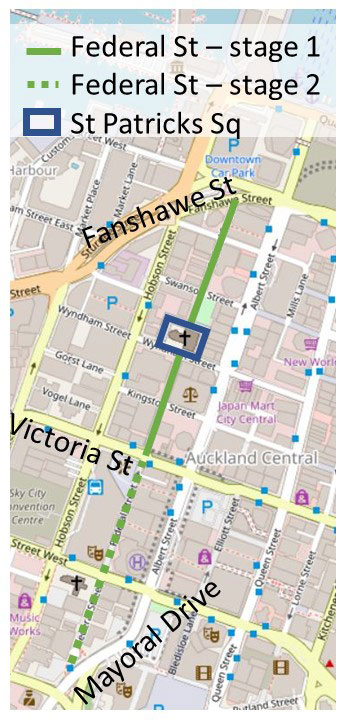
Federal Street contra-flow cycleway map (map database: openstreetmap.org)
Federal Street runs one-way northbound in Auckland’s central business district, from Mayoral Drive near Cook Street to Fanshawe Street near the waterfront. It has lower traffic volumes than the parallel roads (although still averaging 3,000-7,000 vehicles per day), making it a popular route for walking and cycling. Federal Street is interrupted by St Patrick’s Square, with a Cathedral sitting on the direct alignment.
A major upgrade project is planned to enhance Federal Street’s aesthetics and create a shared space, so that it will not only be a practical option, but, more importantly, an attractive option, for walking and cycling.
To enhance the cycle network connectivity of the central city, a southbound contra-flow cycleway is being added to this corridor with the implementation in stages, before the major shared space treatment is installed. The first stage design, as an interim project, was required to be relatively low-cost and quick to install. It consists of a separated cycleway for contra-flow (southbound and uphill) cycling, polka-dot markings at intersections to indicate a shared space environment, and localised pedestrian treatments.
Where two approach traffic lanes had previously been provided at intersections, this was reduced to one lane, to help discourage wrong-way driving whilst not adversely affecting capacity.
The cycleway separation consists of colourful planter boxes and rubber speed humps at driveways. People cycling in the northbound direction can use the general traffic lane (sharrows have been marked within the traffic lanes).
The first section of the cycleway between Fanshawe Street and Victoria Street (470 m) opened in March 2018, with installation taking less than one week.
Project owner: Auckland Transport
Close